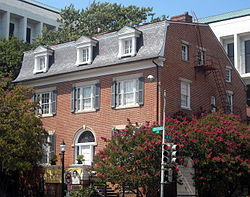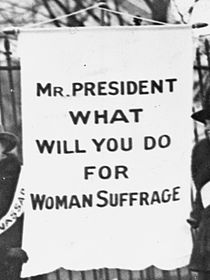Belmont-Paul Women's Equality National Monument
|
Belmont-Paul Women's Equality National Monument; formerly Sewall-Belmont House and the Alva Belmont House
|
|
 |
|
| Location | 144 Constitution Avenue NE Washington, D.C. |
|---|---|
| Coordinates | 38°53′31″N 77°0′13″W / 38.89194°N 77.00361°WCoordinates: 38°53′31″N 77°0′13″W / 38.89194°N 77.00361°W |
| Area | less than one acre |
| Built | 1800 |
| Website | Belmont-Paul Women's Equality National Monument |
| NRHP Reference # | 72001432 |
| Significant dates | |
| Added to NRHP | June 16, 1972 |
| Designated NHL | May 30, 1974 |
 |
|
|
|
The Belmont-Paul Women's Equality National Monument (formerly the Sewall House (1800-1929), Alva Belmont House (1929-1972), and the Sewall-Belmont House and Museum (1972-2016)) is a historic house and museum of the U.S. women's suffrage and equal rights movements located in the Capitol Hill neighborhood of Washington, D.C.. The monument is named after suffragists and National Woman's Party leaders Alva Belmont and Alice Paul.
Since 1929 the house has served as headquarters of the National Woman's Party, a key political organization in the fight for women's suffrage. It was added to the National Register of Historic Places in 1972, designated a National Historic Landmark in 1974. From 1972 to 2016, the Sewall-Belmont National Historic Site was an affiliated unit of the National Park Service. In 2016, President Barack Obama designated it a National Monument, affording it more protection, visibility, and likely more funding.
On June 20, 1632, Charles I, King of England, made a land grant in North America to Cecilius Calvert, 2nd Baron Baltimore which became the Province of Maryland (later the state of Maryland). Lord Baltimore established counties within the province, and provincial courts further subdivided counties into areas known as "hundreds". One of these was New Scotland Hundred. Its southern boundary was the Potomac River, extending from the mouth of Oxon Creek upstream to Little Falls Rapids (a point 10 miles (16 km) downstream from the Great Falls of the Potomac River). On February 12, 1663, the third Lord Baltimore granted a land patent of 1,000 acres (4.0 km2) in New Scotland Hundred to George Thompson. The property (which was now called Duddington Manor) changed hands, was subdivided, and inherited a number of times before it came into the possession of nine-year-old Daniel Carroll in 1773.
...
Wikipedia



